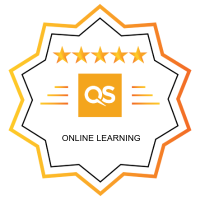260€

Presentación
The realm of data science is experiencing an unprecedented boom, with companies across industries seeking skilled professionals to harness the power of data for strategic insights and decision-making. Our Course in Introduction to Data Science is designed to equip you with the essential skills and knowledge to thrive in this dynamic field. You will explore foundational concepts, tools, and techniques that will empower you to analyse complex datasets and derive meaningful conclusions. As demand for data science expertise skyrockets, participating in this course will not only enhance your analytical capabilities but also open doors to a vast array of career opportunities. Dive into the world of data and become a sought-after expert who can transform data into actionable intelligence. Join us and be part of the data revolution.
Universidades colaboradoras
Para qué te prepara
The Course in Introduction to Data Science equips you with the skills to analyse and interpret complex datasets, allowing you to make informed decisions. You'll learn to use statistical tools and programming languages to extract meaningful insights from data. This course enhances your ability to apply data-driven solutions, identify trends, and communicate findings effectively, making you a valuable asset in any data-oriented role.
Objetivos
- To understand the fundamental concepts of data science and its applications. - To learn to use Python for data manipulation and analysis effectively. - To gain skills in data cleaning and preparation for analysis tasks. - To explore and interpret data using statistical methods and visualisation. - To develop the ability to communicate data-driven insights clearly. - To acquire knowledge in machine learning techniques and algorithms. - To apply data science principles to real-world problem-solving scenarios.
A quién va dirigido
The Course in Introduction to Data Science is designed for professionals and graduates in related fields who wish to enhance or update their knowledge in data science. Ideal for those seeking to understand fundamental concepts and tools, this course provides a solid foundation for leveraging data in their current roles.
Salidas Profesionales
- Junior Data Analyst in various industries - Data Visualisation Specialist for marketing firms - Entry-level Data Engineer for tech companies - Research Assistant in academic institutions - Data Consultant for small businesses - Business Intelligence Analyst in finance sectors - Data Management Assistant in healthcare organisations
Temario
UNIT 1. INTRODUCTION TO DATA SCIENCE
- What is data science?
- - The role of data scientists
- - Stages in the data science process
- Necessary tools for data scientists
- Data science - Cloud computing
- - Defining the concept of cloud computing
- - Characteristics of cloud computing
- - cloud models
- - Virtualization
- - cloud storage
- - Reliable cloud providers for data science
UNIT 2. RELATIONAL DATABASES
- Introduction
- - Advantages and disadvantages of databases
- - General concepts
- - The entity-relationship model
- - The extended entity-relationship model
- - Integrity restrictions
- The relational model
- - The structure of the relational model
- - Keys of the relational model
- - Integrity constraints
- - Normalization theory
- - Design of a relational database
- - Types of relational languages
- Structured Query Language (SQL)
- - SQL Features
- - Database management systems with SQL support
- - Syntax SQL
- - Integrity Constraint Specification
- MySQL. A relational database.
- - Characteristics
- - Type of data
- - SQL Syntax for MySQL
UNIT 3. NOSQL DATABASES AND SCALABLE STORAGE
- What is a NoSQL database?
- - Database
- - Relational databases
- - Indexes
- - Primary key
- - Transaction database
- - SQL language
- - Centralized vs distributed systems
- - array
- - JSON format
- - NoSQL Databases
- Relationship databases Vs NoSQL Databases
- NoSQL Database Types: CAP Theorem
- - Distributed databases: Strategies
- - CAP theorem
- NoSQL Database systems
- - Aggregation models
- - Graph models
UNIT 4. INTRODUCTION TO A NOSQL DATABASE SYSTEM, MONGODB
- What is MongoDB?
- How MongoDB works and its uses
- Getting started with MongoDB: Installation and Command Shell
- Creating our first NoSQL database: Model and data insertion
- Updating data in MongoDB: set and update statements
- Working with indexes in MongoDB for data optimization
- - Execution plans
- - Advantages and disadvantages of index creation
- Querying data in MongoDB
UNIT 5. PYTHON AND DATA ANALYSIS
- Introduction to Python
- - Main Features of Python
- - Programming with Python
- What do you need?
- - Installation
- - Installed utilities
- Libraries for data analysis in Python
- - Mathematical and statistical computations with Numpy and Pandas
- - Machine learning algorithms with scitik-learn
- - Data visualization and representation with Matplotlib
- MongoDB, Hadoop, and Python: The Dream Team of Big Data
UNIT 6. R AS A TOOL FOR BIG DATA
- Introduction to R
- - R Commands
- - R Objects
- What is needed?
- - Installation
- - Additional R packages
- - Development environments for R
- Data types
- - Data reading and import
- - Data writing and export
- - Functions
- Descriptive and Predictive Statistics with R
- Integrating R into Hadoop
UNIT 7. DATA PREPROCESSING AND DATA PROCESSING
- Data collection and cleansing (ETL Process)
- - Data cleansing
- - Characteristics of ETL tools
- Statistical inference
- - Statistical inference in R
- Regression models
- - Regression in R
- Hypothesis testing
- - Hypothesis testing in R
UNIT 8. DATA ANALYSIS
- Business Analytical Intelligence
- Graph theory and social network analysis
- - Introduction to Graph Theory
- - Algorithms for community detection in social networks
- - Social network analysis in R
- Presenting results
Titulación
Claustro
Solicitar información






